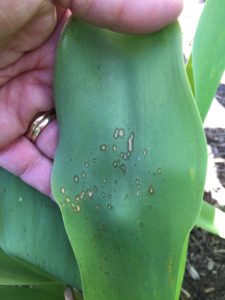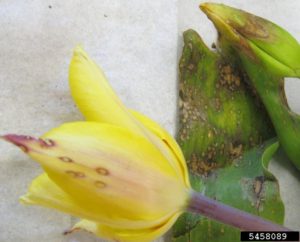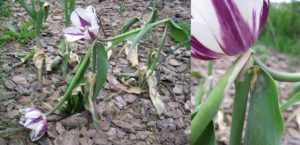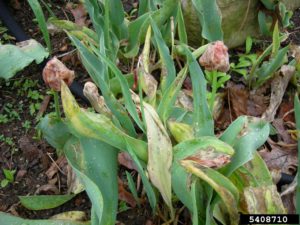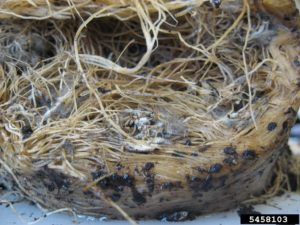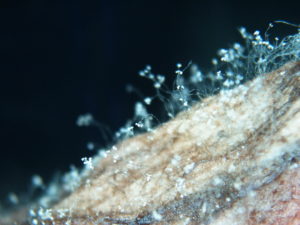The recent jump from Winter to Summer (with 2-3 days of Spring somewhere in there) got folks out looking at Tulips in full bloom now in northern Indiana. The only thing marring the view in one local planting was an outbreak of tulip fire, caused by the fungus Botrytis tulipae. The disease first shows up as small spots on the leaves (Fig. 1) or flowers (Fig. 2) or may cause stem collapse (Fig. 3). Under favorable conditions blighting can be extensive and give the appearance that the plant has been burned, hence the name tulip fire (Fig. 4). There are dozens of species of Botrytis which attack thousands of types of plants but B. tulipae has a particular affinity for tulips and is found around the world.
- Fig. 1: Leaf spot on tulip leaves caused by the fungus Botrytis tulipae. Photo by G. Ruhl
- Fig. 2: Spots on tulip flowers caused by the fungus Botrytis tulipae. Photo by S. Jensen, Cornell Univ.
- Fig. 3: Botrytis infected tulip stems collapse rapidly. Photos by J. Beckerman
When Botrytis infections kill whole leaves the outer bulb scales and roots of the plant may become infected. The fungus then forms small black masses of fungal tissue on the bulb and roots, known as sclerotia (Fig. 5) that are resistant to heat, cold and drying out. These serve as a source of spores (Fig. 6) the next spring which are spread by wind to infect new plants when the weather is wet and cool.
- Fig. 4: Tulip planting with extensive blighting (tulip fire) caused by Botrytis tulipae. Photo by M. Hansen, VPI
- Fig. 5: Sclerotia of Botrytis tulipae on the roots of potted tulip. Photo by S. Jensen, Cornell Univ.
- Fig. 6: Botrytis spores.
Management: In small plantings remove infected leaves and flowers as they show up and any bulbs that become infected. Plant only high-quality tulip bulbs that show no evidence of decay. Plant in areas that have good air movement.
In larger plantings, such as public gardens, managers may wish to protect plantings with fungicide sprays when conditions are favorable for disease development.
